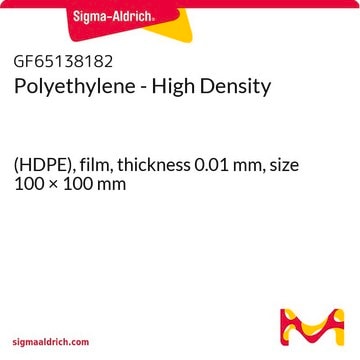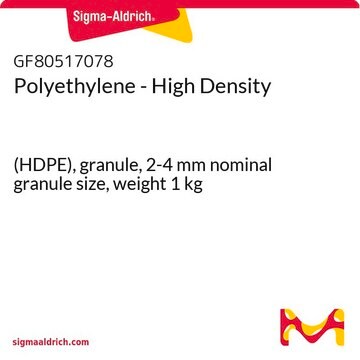427985
Polyethylene
High density, melt index 12 g/10 min (190 °C/2.16kg)
Sign Into View Organizational & Contract Pricing
All Photos(2)
About This Item
Linear Formula:
H(CH2CH2)nH
CAS Number:
MDL number:
UNSPSC Code:
12162002
PubChem Substance ID:
NACRES:
NA.23
Recommended Products
Quality Level
form
pellets
melt index
12 g/10 min (190 °C/2.16kg)
hardness
66 (Shore D, ASTM D 2240)
mp
125-140 °C
transition temp
softening point 125 °C (Vicat, ASTM D 1525)
density
0.952 g/mL at 25 °C
SMILES string
C=C
InChI
1S/C2H4/c1-2/h1-2H2
InChI key
VGGSQFUCUMXWEO-UHFFFAOYSA-N
Looking for similar products? Visit Product Comparison Guide
Related Categories
Application
Injection molded car seats, mower parts and pails.
Features and Benefits
Excellent stiffness and impact and warp resistance.
Storage Class Code
11 - Combustible Solids
WGK
WGK 3
Flash Point(F)
Not applicable
Flash Point(C)
Not applicable
Personal Protective Equipment
dust mask type N95 (US), Eyeshields, Gloves
Choose from one of the most recent versions:
Already Own This Product?
Find documentation for the products that you have recently purchased in the Document Library.
Customers Also Viewed
Maria C S Inacio et al.
Acta orthopaedica, 84(2), 145-152 (2013-03-15)
There is no substantial clinical evidence for the superiority of alternative bearings in total knee arthroplasty (TKA). We compared the short-term revision risk in alternative surface bearing knees (oxidized zirconium (OZ) femoral implants or highly crosslinked polyethylene (HXLPE) inserts) with
Morteza Meftah et al.
The Journal of bone and joint surgery. American volume, 95(13), 1193-1197 (2013-07-05)
Ceramic femoral heads produce less wear of the opposing polyethylene than do metal femoral heads in wear simulation studies. This is a matched-pair analysis of the wear of ceramic and metal femoral heads on conventional polyethylene in uncemented total hip
Eliandra Mirlei Rossi et al.
Journal of infection in developing countries, 7(3), 229-234 (2013-03-16)
Contaminated sponges might lead to cross-contamination in kitchens since they can transfer microorganisms to surfaces where microorganisms can survive for hours or days and contaminate food. The main objective of this study was to evaluate the transfer and the survival
[Technologies for manufacturing ultra-high molecular polyethylene-based porous structures for bone implants].
A V Maksimkin et al.
Meditsinskaia tekhnika, (2)(2), 16-20 (2013-06-26)
Mahtab Memarpour et al.
The journal of adhesive dentistry, 15(1), 85-91 (2013-03-28)
To evaluate the clinical performance of polyethylene fiber for anterior primary teeth restorations in children after 2.5 years, according to modified Ryge criteria. Fifty-five maxillary incisors with extensive caries in 24 Iranian patients (mean age 4.2 years) were restored. All
Our team of scientists has experience in all areas of research including Life Science, Material Science, Chemical Synthesis, Chromatography, Analytical and many others.
Contact Technical Service



